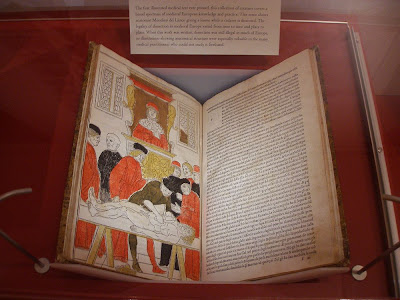 I have to show you one more book from the Beautiful Science exhibit at the Huntington.
I have to show you one more book from the Beautiful Science exhibit at the Huntington.I took other pictures. The light bulb shot didn't turn out so well (sorry, d53, I guess you'll have to go see them in person). And the red room - well, it's red. It's not orange. I know, excuses. But the book pics are fine, plus I love this one. Isn't it - what's the word - quaint?
As I mentioned in yesterday's post, Dan Lewis, the Huntington's Dibner Senior Curator for the History of Science and Technology, put together this exhibit called Beautiful Science. John and I went to the curator's tour the other night. Mr. Lewis is the guy who wrote the cards perched next to the various books and items in the exhibit, so he's the guy who wrote this:
"The first illustrated medical text ever printed, this collection of treatises covers a broad spectrum of medieval European knowledge and practice. This scene shows anatomist Mondino dei Liuzzi giving a lesson while a cadaver is dissected. The legality of dissection in medieval Europe varied from time to time and place to place. When this work was written, dissection was still illegal in much of Europe, so illustrations showing anatomical structure were especially valuable to the many medical practitioners who could not study it firsthand."
I managed to cut off the top of the card so I don't know if this book is Andreas Vesalius’ treatise on human anatomy, De humani corporis fabrica (1543), described on the Huntington's website. But it could be, and if not, okay, well that's in the exhibit, too.
15 comments:
Two things.
Firstly, Beautiful Science is exactly the kind of exhibition that warms the cockles of my curiosity. Wow! Thank you for bringing to our attention.
Secondly, I received your invitation, which I accepted immediately, but there seems to be something amiss with my FB account, and I'm not certain my response was properly processed.
If this is the case, please try again.
And, again...wow!
P, I'm hoping KB will be able to bring one of these tombs home for each of us.
It is fascinating to see such a thing. They look like they're slicing into the guy in Leonardo's illustration of human proportions in a circle/square. Your photo had me running to find out when Gutenberg launched the printing press, and the dates fit the tome you suggest.
Fun stuff!
You're persuasive, I'll make sure not to miss it. Besides, nothing beats a good old fashioned autopsy
That’s not Vesalius. His engravers produced work such as this.
As far as I know, that crude block-color printing predates Vesalius’s editions by at least a generation.
The Huntington sure knows how to put together fabulous exhibits! I'm so jealous you can just pop by any time. How fun to just stare intently at all the amazing details; and learn a bit too! Hmm, I feel the pull of Pasadena getting stronger.
I hate to be a bubble burster, but isn't taking photos of museum exhibits technically theft? I mean I may be wrong but... the way I see it, it sounds similar to going into a movie theater and taking photos of the movie.
Okay, bad example...
No bubbles burst in the making of this post. You can ask the caretakers at Huntington where and when photos can be taken, and they'll tell you. Actually, it's permitted in many galleries.
Thanks, Lucio. The blog is now legitimized on Facebook. Yes, I think this is just the thing you'd like - it engages the intellect as well as the soul.
Sure, C.O. The docents always get free rare books. In fact I'm thinking of volunteering just so I can get me a Shakespeare first folio. And since you mention it, there's a tiny casket in this exhibit with an ivory cadaver in it. I'm hoping to have it as a party favor.
Elaine, if/when you visit, it's the first place we'll go.
Karin, I don't want to know how you know that.
Thanks, Bernie. I wasn't sure what it was because I didn't have the foresight to take notes. Some lessons need to be learned more than once.
Katie, you're the only person I've ever met who thinks of Pasadena as a vacation destination. Yet 100 years ago, it was THE place to go.
Thanks to AH for clearing up Lindsey's question. (AH is studying to be a docent in the gardens!)
You bring up a good point Lindsey: I did ask the curator for permission, and it was fine with him as long as I didn't use a flash. It's always good to check, though. Some museums have signs posted, and in my experience most prohibit flash photography if they allow photos at all.
Is there a connection between the Huntington Library and Huntington Beach?
Yeah, the 10 freeway! (Sorry. I'm sorry.)
Vanda, it's an excellent question. The Huntington Beach official website states that the town was originally developed by one Henry Huntington, the same railroad magnate who built the Huntington estate in San Marino and founded the library with his great collections.
Well I can certainly understand flash photography prohibition in zoos as they might agitate animals, but why museums?
Two more things.
Firstly, your blog legitimises itself! I am merely a grateful fan.
Secondly - you know me well, Petrea.
Lindsey, it's because the light in the flash can damage pigments in the artworks and books.
Lucio, how do we manage that across continents? Communication is more than words and pictures. Intuition must play a part.
Post a Comment